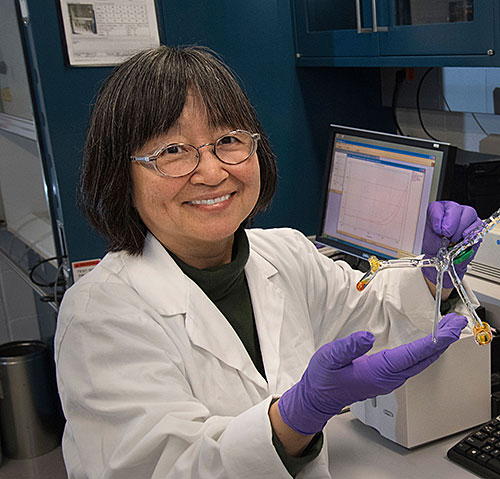Brookhaven Lab Partners in New $40 M Research Center to Convert Sunlight to Liquid Fuels
Scientists aim to advance the design and performance of hybrid molecular-semiconductor photoelectrodes to generate liquid fuel from sunlight
August 5, 2020

CHASE will advance the design and performance of hybrid molecular-semiconductor photoelectrodes. The goal is to integrate molecular catalysts with semiconductor surfaces to convert sunlight to liquid fuels in a single system.
UPTON, NY—The U.S. Department of Energy (DOE) has announced $40M in funding over five years for a new research center aimed at developing hybrid photoelectrodes for converting sunlight into liquid fuels. Chemists from DOE’s Brookhaven National Laboratory will be key partners in this effort, dubbed the Center for Hybrid Approaches in Solar Energy to Liquid Fuels (CHASE), which will be led by the University of North Carolina at Chapel Hill (UNC) and includes additional collaborators at Emory University, North Carolina State University, the University of Pennsylvania, and Yale.
“Sunlight is the world’s most basic energy source, and an ability to generate fuels directly from sunlight has the potential to revolutionize the U.S. energy economy,” said Under Secretary for Science Paul Dabbar in a press release announcing the award. “This effort will keep America at the forefront of artificial photosynthesis research, a field of great challenge but also huge promise.”
 enlarge
enlarge
Brookhaven Lab chemist Javier Concepcion will serve as the institutional coordinator for Brookhaven's contributions to CHASE.
The field is dubbed artificial photosynthesis because it aims to mimic certain aspects of how green plants capture and use sunlight to transform simple raw materials (carbon dioxide and water) into more complex chemicals such as carbohydrates. But instead of generating sugars and starches as plants do, CHASE scientists aim to use such systems to store the sun’s energy in the bonds of higher-value carbon-based liquid fuels.
The Brookhaven team has extensive experience developing, characterizing, and optimizing the performance of the catalysts that enable key steps of these chemical conversions, and also linking them with light-absorbing semiconductor materials needed to capture solar energy. The CHASE strategy is to advance the design and performance of hybrid molecular-semiconductor photoelectrodes by integrating molecular catalysts with semiconductor surfaces to perform all the steps to convert sunlight to liquid fuels in a single system.
 enlarge
enlarge
Brookhaven Lab chemist Etsuko Fujita, a leader of Brookhaven's artificial photosynthesis research effort.
“We’re looking forward to getting started on such an exciting journey,” said Brookhaven chemist Javier Concepcion, who will serve as the institutional coordinator for Brookhaven’s contributions. “The generation of liquid fuels from sunlight using water, carbon dioxide and nitrogen as feedstocks is one of the key challenges for the scientific community in the 21st century. The Brookhaven team, in collaboration with our partner institutions, is ready to face that challenge and develop the basic science that will revolutionize this field.”
“Some of the key challenges will be assembling molecules at the interfaces of materials and making all the pieces work together through extremely complex processes covering a wide range of timescales,” he added. “Brookhaven Lab’s research facilities will play a key role in unraveling these complex phenomena.”
“Advancing the science for such ‘sustainable chemical conversions’ is a cornerstone of Brookhaven Lab’s research strategy,” said James Misewich, Brookhaven Lab’s Associate Laboratory Director for Energy Sciences, who is on the governance board of CHASE. “This research will leverage our expertise and capabilities, including our world-class research facilities.”
These facilities include the Chemistry Division's Accelerator Center for Energy Research, which will be used for mechanistic studies of reactions that are central to artificial photosynthesis, as well as the National Synchrotron Light Source II (NSLS-II) and the Center for Functional Nanomaterials (CFN), two DOE Office of science user facilities that will enable studies of surface interactions, molecular structures, and chemistry-as-it-happens.
“We will pursue our proposed research with determination to obtain world-recognized results,” said Brookhaven chemist Etsuko Fujita, a leader of Brookhaven’s artificial photosynthesis research effort. “These results may help solve many problems associated with global warming, energy, and environmental issues, and we are grateful to have this opportunity to tackle these important challenges.”
Additional Brookhaven Lab CHASE members are Zahid Ertem, David Grills, Gerald Manbeck, Dmitry Polyansky, and Jose Rodriguez, all of the Chemistry Division. Emilio Mendez, Brookhaven’s Director of Energy Sciences, serves with Misewich on the CHASE governance board.
“We have assembled a very strong team to set brand-new directions in this field,” said Gerald Meyer, director of the CHASE Center at UNC. “Our focus is to use the sun’s energy to directly generate storable liquid fuels.”
CHASE will be funded by the DOE Office of Science.
Brookhaven National Laboratory is supported by the U.S. Department of Energy’s Office of Science. The Office of Science is the single largest supporter of basic research in the physical sciences in the United States and is working to address some of the most pressing challenges of our time. For more information, visit https://www.energy.gov/science/
Follow @BrookhavenLab on Twitter or find us on Facebook
2020-17370 | INT/EXT | Newsroom









